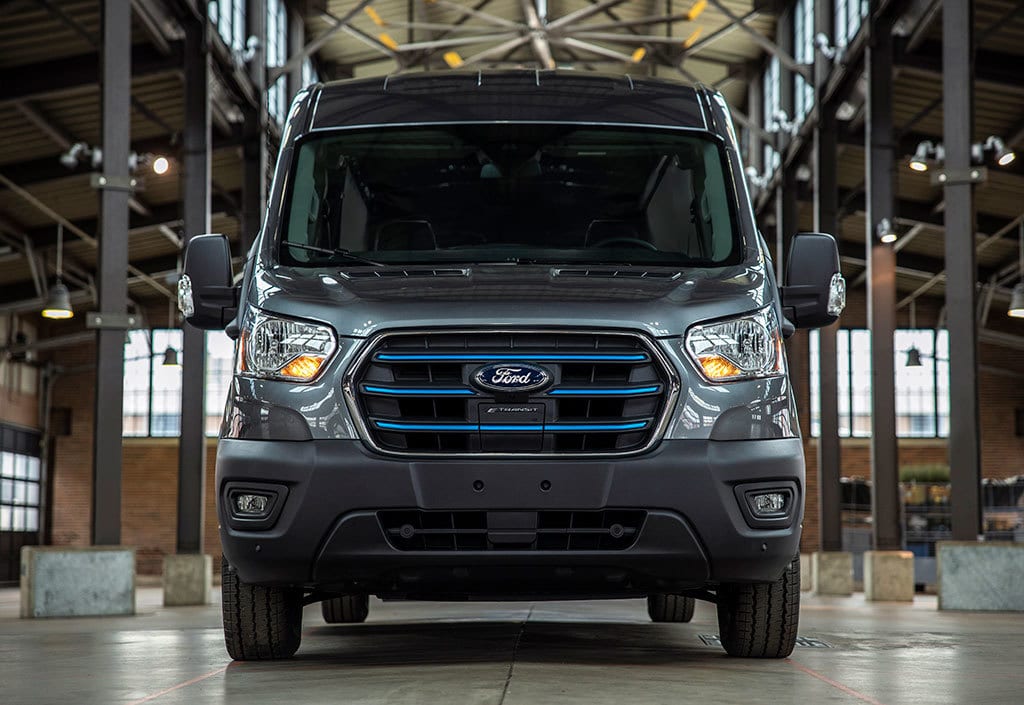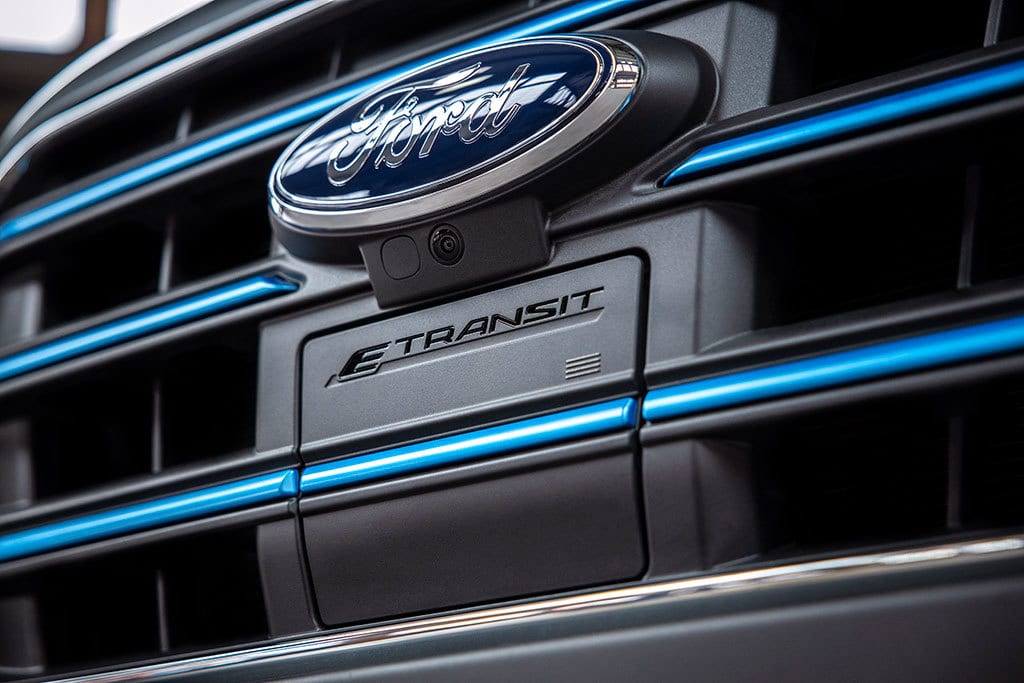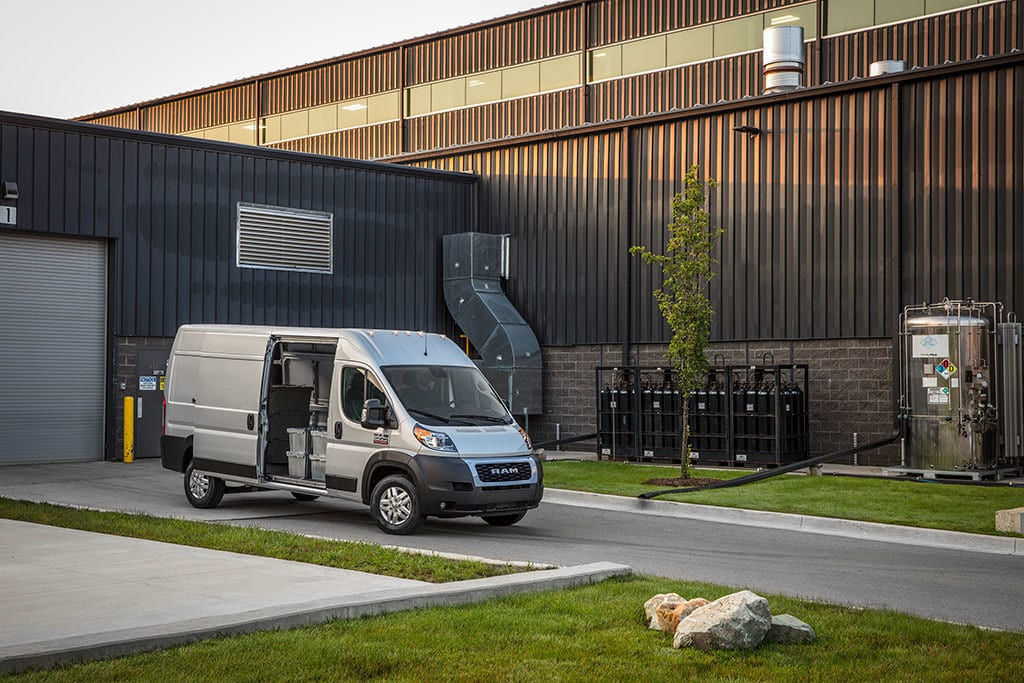Electric vehicles
creatE a buzz for contractor customers
Supply chain shortages
affecting new vehicle lead times
for commercial vehicles.
Ford’s new 2022 E-Transit is available with Pro Power Onboard, which provides 2.4 kW of power for contractors on job sites.
Supply chain shortages affecting new vehicle lead times for commercial vehicles.
BY NICOLE KRAWCKE
A contractor’s fleet is one of its most important assets. These are more than just vehicles — they are mobile billboards for advertising, storage for parts, tools and other accessories, and ensure the technician arrives at the job in a timely, professional manner.
Today’s commercial vans and trucks are loaded with safety and comfort features, but more and more PHVAC contractors are looking for increased vehicle uptime, partly due to supply shortages.
“Fleets are increasingly measuring best value compared to lowest price,” explains Kevin Koester, senior director for NTEA — The Association for the Work Truck Industry. “More recently, fleets are factoring in a greater focus on maintenance of existing vehicles. It’s becoming commonplace to review existing maintenance practices for opportunities to lengthen the life of vehicles in operation.
“While plumbing and HVAC services continued to be required and essential throughout the pandemic, the automotive market was hit with its own challenges,” he adds. “Plant shutdowns and the ongoing chip shortage have created a long order backlog, which had a significant impact on fleets’ ability to replace aged vehicles. This means fleets with an out-of-service truck may not be able to replace or even rent a vehicle without potentially long delays. To protect their operations, many fleets are increasing preventative maintenance efforts.”
Drew Walker, Ford brand manager for Transit and Transit Connect, agrees that Ford contractor customers are looking for ways to maximize vehicle uptime and employee productivity.
“This manifests itself in a number of ways, including taking advantage of new ways to maintain vehicles such as Ford Pro’s mobile service offerings, specifying more driver-assist technology on the vehicles to increase driver confidence, help maintain fleet driving standards and taking advantage of built-in vehicle modems and telematics to manage and optimize vehicle efficiency,” Walker explains. “Maximizing uptime is important because workers are hard to find, vehicle supply is tight and demand for contractor services is high.”
Ram Commercial business customers are still looking for capability and efficiency, but are demanding advanced safety features more and more often, notes Dave Sowers, head of Ram Commercial.
“The 2022 Ram ProMaster has a host of standard safety features including full-speed forward collision warning, post-collision braking, drowsiness detection, traffic sign recognition, rear camera with dynamic gridlines, push-button starter and an electric parking brake,” he says. “Businesses want to protect their employees, investments, the public and their reputation. Accidents can be damaging to any of those things. Businesses with typical fleet sizes can expect to recover the initial investment in those safety features through reduced accident expenses and less downtime over the life of that vehicle and their fleet in total.”
“The E-Transit offers everything contractors love about the Transit — including its uncompromised cargo capacity and versatility — in an all-electric package.” – DREW WALKER

Ford’s E-Transit comes in three lengths and three roof heights. It's also available in chassis cab and cutaway models, Ford notes.


Ford Telematics also allows contractors and fleet managers to monitor battery range and state of charge; integrate charge station controls, improve asset utilization through GPS tracking with geofencing capabilities; and maximize vehicle uptime with maintenance alerts and service reminders.
Electric rolling into the commercial market
We may not be living in George Jetson’s world of flying cars, but all-electric vehicles are gaining traction amongst commercial customers.
“We are seeing tremendous interest in the all-new E-Transit electric cargo van,” Walker says. “The E-Transit offers everything contractors love about the Transit — including its uncompromised cargo capacity and versatility — in an all-electric package. E-Transit has the same interior cargo dimensions of current Transit vans, making it easy for current customers to transfer many of their existing rack and bin systems and other upfits seamlessly to the electric van. Plus, electric vehicles like E-Transit offer a range of additional benefits including zero emissions for a healthier planet, lower overall total cost of ownership and the ability to go where vehicles powered by internal combustion engines cannot.”
Walker also notes that the E-Transit is available with optional Pro Power Onboard, which provides up to 2.4 kilowatts of power for contractors to transform the vehicle into a mobile generator that powers tools and equipment on job sites and on the go.
Ram ProMaster announced it will have an electrified version by 2023. Sowers expects to see early adoption of electric vehicles by large fleets and a more gradual adoption by smaller fleets.
As interest in electric vehicles and product offerings grows, electric vehicle sales expectations remain high, Koester points out.
“However, infrastructure and charging cycles may present challenges based on the drive and duty cycle of some vocational fleets,” he says. “Specific to plumbing/HVAC fleets, most are centrally domiciled and may have an opportunity for charging during non-use periods. Another factor to consider is these purpose-built vehicles often carry a longer service life. It’s important to understand the full picture for an individual fleet, as drive cycle, duty cycle and full life-cycle analysis will impact the ability to onboard an electric vehicle.”
The 2022 Ram ProMaster features improved safety features, including Crosswind Assist, which detects strong gusts of wind, helping drivers stay on course; Blind Spot Monitoring; Forward Collision Warning with Active Braking, which applies partial braking to help mitigate potential collisions while giving drivers time to react; and Digital Rearview Mirror, which features an LCD monitor (that can be turned off to revert to a reflective mirror) that offers a real-time video stream. And available on Ram ProMaster Cargo Vans, Blind Spot Monitoring with Rear Cross Path Detection, which helps avoid accidents and enhance safety and security by warning drivers when vehicles enter the van’s blind spot zones.
The bells and whistles
According to Christopher Lyon, director of fleet relations for NTEA, the top sought-after features for commercial trucks and vans are often purpose-driven depending on the trade and vocation.
“As fleets continue to balance the bottom line, right-sizing and proper upfits are the key strategies used,” he says. “Both the end-user and upfitter need to understand the organization’s mission and design the appropriate vehicle.”
Walker notes the new E-Transit’s Pro Power Onboard received a lot of publicity after people in Texas used it to charge their homes during the massive power outage in the spring, which has driven increased interest.
“Most of our most popular Ford Co-Pilot360 technology is standard on Transit and E-Transit, including lane-keeping system and pre-collision assist with automatic emergency braking,” he says. “Popular optional features include blind spot assist with Blind Spot Information System, a 360-degree camera and reverse brake assist.”
Additionally, there are several new technology features that have also included a buzz, such as Intelligent Adaptive Cruise Control with Speed Sign Recognition and Intelligent Speed Assist. “These features work together to identify speed limits and automatically change the vehicle speed accordingly,” Walker says.
Vocational customers such as plumbers and electricians have always been interested in capability and efficiency, and recent trends have seen a growth in demand for safety fworksiteeatures, Sowers notes.
“Forward collision mitigation is the highest demanded safety feature currently, but customers are also looking to prevent minor collisions and work site collisions,” he says. “All business customers big and small are looking for a higher level of connectivity with their vehicles as well.”
“We’ve improved the efficiency of ProMaster with updates to the engine, the addition of a 9-speed automatic transmission and electric power steering, which combine for a 9% improvement in fuel economy and reduced cost of ownership.” – DAVE SOWERS


Ram offers specialized plumbing and HVAC vehicle upfits to help contractors configure and customize their ProMaster vans.

What’s new in 2022
In addition to the new E-Transit, Ford’s all-new F-150 Lightning truck will debut in 2022, giving contractors who prefer a pickup truck to a van an all-electric option, Walker says.
Sowers notes that Ram has made a significant investment in the 2022 ProMaster in areas that are most important for business customers.
“We’ve improved the efficiency of ProMaster with updates to the engine, the addition of a 9-speed automatic transmission and electric power steering which combine for a 9% improvement in fuel economy and reduced cost of ownership,” he says. “Significant advancements in connectivity and safety have also been made by bringing in forward collision warning and optional features such as blind-spot monitoring, Active Driving Assist and Adaptive Cruise Control with Stop and Go. The 2022 Ram ProMaster also includes L2 autonomy (Active Driving Assist) which is the highest level of autonomy that still requires you to keep your hands on the wheel.
“Additionally, the all-new Ram vehicles for 2022 feature standard telematics connectivity,” Sowers adds. “Ram was thinking specifically about vocational customers such as plumbers and electricians when investing and redesigning the 2022 ProMaster to meet their current needs.”
“Some organizations are shifting platforms just to ensure they have vehicles. Contractors need to know the core mission of their vehicles and procure accordingly.” – Christopher Lyon
Overcoming supply challenges
As Koester previously mentions, the supply chain shortages — most notably microchips — have severely impacted the automotive industry, emptying dealership lots and creating long lead times for new vehicle orders. And no one knows with certainty when the supply chain issues will normalize.
“Supply chain disruptions continue,” Lyon says. “Limited production and production delays due to the chip shortage are impacting chassis availability, and ordering windows in many cases are closing early. Fleets replacing vehicles may face extended delivery times or short ordering windows, which can add expenses and defer maintenance by keeping vehicles in service longer than expected.”
Lyon advises that it’s important for plumbing and heating contractors to understand the larger picture.
“With supply disruptions, many vehicles have extended order times or are not even available,” he says. “Some organizations are shifting platforms just to ensure they have vehicles. Contractors need to know the core mission of their vehicles and procure accordingly. As noted, vocational trucks often carry a longer service life, and making purchasing decisions based on vehicle availability can severely impact operational costs over the life of the vehicle.”

Photos courtesy of Ford Motor Co. and Ram Commercial.
Nicole Krawcke is chief editor of Plumbing & Mechanical.
